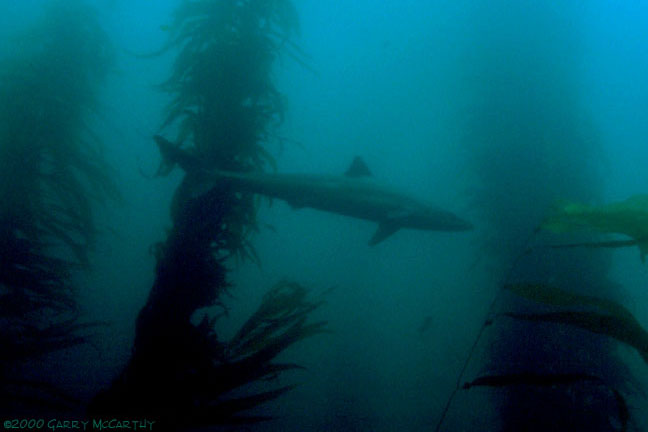
An unusual amount of dead sharks have been washing up on north Oregon coast beaches in the last few weeks. Most have appeared in a stretch roughly 40 miles long, from Rockaway Beach to Fort Stevens, although one showed up on the southern Washington coast.Staff at the Seaside Aquarium have been keeping track of the reports and taking the carcasses in; one appeared to be still alive when it initially washed up.Tiffany Boothe, education specialist at the aquarium, said 4 salmon sharks and 4 soupfin sharks washed up in an approximate 4-week period, from 22 Jul to 22 Aug 2007."It's the most we've ever seen in such a short period of time," Boothe said. "Usually, when they die, they sink to the bottom. But the dead ones have been washing up on the beaches."Why or how so many have been showing up on shore is a mystery, but Boothe and others at the aquarium believe it probably has to do with warmer waters this year [2007] bringing in more tuna. That, in turn, will attract more fish-eaters."These sharks are fish-eaters," Boothe said. "We've had warmer waters this year [2007], warmer than usual. I don't know if it's global warming or not, but it's probably just because we've had nothing but south winds, and the south winds warm things up. The tuna are probably coming in because of that. They're about a mile offshore, but that brings in the fish-eaters."Boothe also thinks it's possible the shark carcasses are the result of fishermen accidentally snagging them. "They could be by-catch," she said. "They get caught in their nets, and the fishermen throw them over. They don't survive that because sharks are really quite sensitive."Near the end of July 2007, the much-publicized salmon shark that washed up in Rockaway Beach was next. Boothe wasn't totally convinced that was a salmon shark, however. After seeing video footage of it, she said it looked more like a Great White. "The snout looked all wrong," she said. "And it was really big. I've never seen a big salmon shark in person, and I didn't see this one in person. So I can't say for sure. But to me it looks more like it was a Great White."Cannon Beach video correspondent Dave Pastor took that footage, which was aired all over Portland TV stations. Neither he nor the aquarium know what happened to it after it washed up on Sunset Beach.Another salmon shark washed up on Arch Cape on 6 Aug 2007, apparently still alive for a small period of time. "It was about 4-5 feet long, and they found it in a pool of blood," Boothe said. "It was alive when it was 1st reported but it later disappeared. We don't know if someone took it or if it washed back into the ocean."On 15 Aug 2007, a soupfin washed up in Fort Stevens State Park, just south of Astoria. On 18 Aug 2007, another dead soupfin showed up on a beach somewhere north of Gearhart. Aquarium staff weren't sure as to the exact location, as they never actually dealt with it themselves and only recorded the report.21 and 22 Aug 2007 saw a different salmon shark on both days washing up at the Tolovana Beach area of Cannon Beach.Possible sightings of sharks in Rockaway Beach led to a posted warning earlier this month [August 2007], although this was unrelated to the dead sharks washing ashore.On 23 Aug 2007, a soupfin shark drifted in around Beard's Hollow on the Washington coast.Three of the sharks have wound up in a freezer at the aquarium, awaiting donation to local schools for science labs."We've been really busy this summer [2007], and these are not our top priority," Boothe said. "So we don't always get out and collect them."Boothe said salmon sharks are related to Mako sharks and Great Whites, and they are presumed to be only fish-eaters. "There's never been any documentation of them biting a human," she said.Boothe theorized the north Oregon coast could be experiencing the same problem as central California's coast, where lots of dead sharks have shown up."Scientists there have collected nearly a dozen dead juvenile salmon sharks in the past month," [August 2007] she said. "Stanford University and Long Marine Lab at UC Santa Cruz have performed necropsies on the sharks they collected. Their findings were puzzling. All of the sharks had a brain infection caused by a bacterial disease called encephalitis, though they don't know the source of the bacteria. They're not sure if they caught it somehow or the bacteria were already in their systems."Boothe said soupfin sharks can be found in temperate and subtropical seas in the eastern Pacific, from Canada to Baja [Baja California, Mexico]. "They are a highly migratory species with small schools migrating toward the poles in the summer and then back toward the equator in the winter," she said. "Soupfins can be found in the surf or at depths over 1700 feet. Feeding on a variety of fish, the soupfin sharks are not considered a threat to humans. They are highly prized for their fins, which are the main ingredient in shark fin soup."
No comments:
Post a Comment